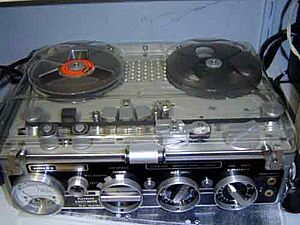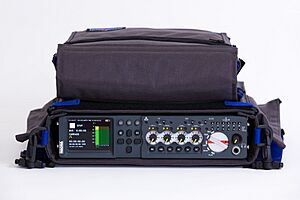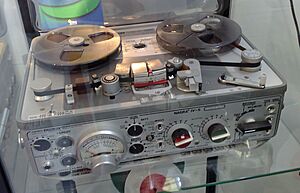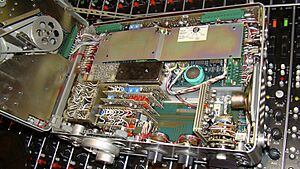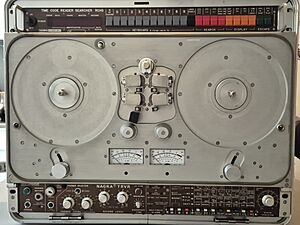Nagra facts for kids
Nagra is a famous brand of portable audio recorders. These recorders have been made in Switzerland since 1951. In 1997, Nagra also started making high-quality sound equipment for people who love great audio. This helped the company grow into new areas.
Nagra recorders were first made by the Kudelski Group. Today, they are designed, built, and sold by a separate company called Audio Technology Switzerland S.A. This company is located in Romanel-sur-Lausanne, Switzerland.
Contents
How Nagra Recorders Started
The first Nagra machines were designed by a Polish inventor named Stefan Kudelski. His company won many awards for how precise and reliable their recorders were. The name "Nagra" means "[it will] record" in Polish, which was Kudelski's first language.
From the 1960s to the 1990s, Nagra tape recorders were the main way to record sound for movies and TV shows that used a single camera. They were considered the best in the industry.
Keeping Sound and Picture in Sync
When movies were first made, it was important for the sound to match the picture.
- Early Sync: At first, a cable connected the Nagra recorder to the camera. This cable sent a special pulse from the camera onto the tape. This made sure that the sound and picture stayed perfectly together, even if the tape speed changed a little.
- Crystal Sync: Later, a new technology called crystal sync was invented. This meant the recorder and camera each had their own very accurate clock. They could work separately but still stay in sync. This gave sound recordists much more freedom to move around. This method was often called "double system sound."
Exploring Nagra Recorder Models
Nagra recorders are named with a number that shows their generation and features.
Early Nagra Models
- NAGRA I (1951): This was the very first test model. It used a clockwork motor and small tubes. Only two were sold.
- NAGRA II (1953): This was the first model made for sale. It also had small tubes and a clockwork motor. Later versions, like the Nagra II c, used early printed circuit boards.
- NAGRA II CI (1955): This was an improved second generation model. It used printed circuit boards instead of lots of wires.
Nagra Models for Film Work
- Nagra III NP (1958): This was the first Nagra recorder that could be used for making films. It recorded sound in mono (single channel). The "NP" meant it used a special "Neopilot" system for syncing.
- Nagra IV-L (1968): This was a mono recorder with Neopilot sync. It had two inputs for microphones and a built-in audio limiter to prevent sound from getting too loud.
- Nagra 4.2 (1972): Similar to the IV-L, but it could power microphones and had built-in sound equalizers. In the 1980s, you could add SMPTE timecode to it.
- Nagra IV-S (1971): This was the first stereo Nagra, meaning it could record two sound tracks. It had controls for sound levels, limiters, and equalizer settings. It used a different sync signal than earlier models.
- Nagra IV-STC (1984): This version of the IV-S added SMPTE timecode support. Timecode helps to perfectly match sound to video.
- Nagra IV-SJ: This stereo Nagra was made for scientific measurements and logging. It had switches for precise sound gain instead of knobs.
- Nagra IS (1974): This was a smaller, simpler recorder. It was designed to be easy to use for film and broadcast work. It was lighter than the IV/4-series recorders.
- NAGRA E (1976): A simple, single-speed, mono recorder made for radio reporters.
All the machines mentioned above used 1/4-inch tape. Nagra also made a studio recorder called the Nagra T-Audio, mostly used in film studios.
Special Rack-Mounted Recorder
- NAGRA TRVR: This was a rare stereo machine designed to fit into a 19-inch rack. It was a reel to reel 1/4-inch tape recorder used for recording for long periods automatically. It could start recording when it detected sound and switch to another machine when the tape ended. With an extra part called the RCHS, it could quickly find specific parts of a recording using time codes. These machines were used by intelligence services and radio stations for logging.
Miniature "Série Noire" Recorders
Kudelski SA also made a series of very small reel-to-reel recorders. These used a special tape that was about 3.81 millimeters wide. These machines were called SN, which stands for "Série Noire" (Black Series). The idea for these recorders originally came from President Kennedy for the United States Secret Service.
The SN range includes:
- Nagra SNN: A mono recorder that used the full width of the tape.
- Nagra SNS: A mono recorder that used half the tape width, allowing for longer recording times.
- Nagra SNST: A stereo recorder, mainly used by security services to record two different people talking.
- Nagra SNST-R: A high-quality stereo version.
A special version of the SN used unique tape cassettes and was used by US intelligence agencies.
Nagra's Digital Recorders
The Nagra IV-STC was the top choice for film and music recording until the mid-1990s. That's when DAT recorders became reliable. Nagra then made digital recorders to keep up.
- Nagra D (1992): This was a 4-channel digital audio recorder. Instead of DAT, it used a special digital reel-to-reel format with 1/4-inch tape. It was quite heavy, which made it less popular with some sound mixers. However, many films were still made using the Nagra D and the newer Nagra DII.
- Nagra ARES C and ARES- PP (1995): The ARES-C was made to replace the older NAGRA-E for radio broadcasting. It was a portable, battery-powered recorder that used PCMCIA memory cards instead of tape. It could record, edit, and send audio. The ARES C-PP was a studio version used in radio stations.
- Nagra V (2002): This was a 2-channel digital audio recorder. It recorded high-quality sound (24-bit/96 kHz) onto removable hard drives and supported SMPTE timecode. It was much lighter than previous models.
- Nagra VI (2008): This recorder started as a 6-channel machine and was later updated to 8 channels. It has four microphone inputs and can record high-quality sound. It records to an internal hard drive and can use compact flash cards for backup. It also has full timecode features.
- Nagra Seven (2013): This 2-track recorder was designed to replace several older Nagra models. It's very flexible and can be set up for different uses, like broadcasting or film. It can even have optional WiFi/3G or WiFi/4G for sending audio.
Nagra for High-Quality Home Audio
In 1997, Nagra started making equipment for people who want the very best sound quality at home. This included special amplifiers and other devices. Since then, they have added many products like tube and mosfet amplifiers, CD players, and digital-to-analog converters (DACs).
Nagra Recorders in Movies
Nagra audio recorders have appeared in many films, often as props or central to the story:
- Help! (1965): A Nagra III was used to record The Beatles' song "I Need You."
- Klute (1971): Features a Nagra SN.
- THX 1138 (1971): Shows a Nagra III.
- The Conversation (1974): A Nagra SN is a key part of the plot.
- Diva (1981): A recording made by a Nagra IV-S is central to the film's story.
- Blow Out (1981): Features Nagra III and Nagra SN.
- Gorillas in the Mist (1988): Shows a Nagra III.
- The Russia House (1990): Features a Nagra III.
- Sneakers (1992): Shows a Nagra III.
- Voci notturne (ep. 2, 1995): Features a Nagra 4.2.
- Spy Game (2001): Shows Nagra IV and Nagra SN.
- The Life Aquatic with Steve Zissou (2004): Features a Nagra 4.2.
- The Informant! (2009): A Nagra SNST is seen at the beginning and throughout the film.
Nagra Recorders in Music
Nagra recorders have also played a role in famous music recordings:
- Simon & Garfunkel: Paul Simon, Art Garfunkel, and others recorded the rhythm for their song "Cecilia" on a Nagra recorder. The recorder accidentally created an echo effect as they hit a guitar case, piano bench, and their legs.
The Nagra IV-S was used to record parts of these famous albums:
- The Beatles "Let It Be" (1970)
- Pink Floyd "The Dark Side of the Moon" (1973)
- David Bowie "Heroes" (1977)
- Led Zeppelin "In Through the Out Door" (1979)
- Michael Jackson "Thriller" (1982)
- AC/DC "Blow Up Your Video" (1988)


